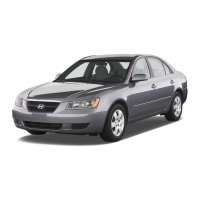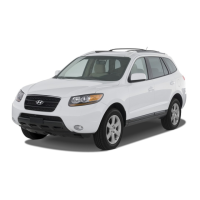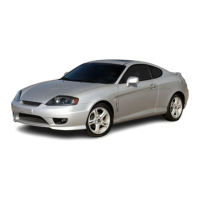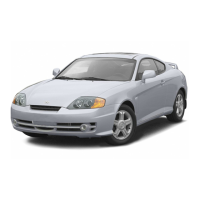Do you have a question about the Hyundai 2008 Tiburon and is the answer not in the manual?
Explains the meaning of various indicator symbols displayed on the instrument panel.
Discusses recommended and prohibited fuels for your Hyundai vehicle.
Provides recommendations for the first 1,200 miles to ensure economical operation and durability.
Describes the three stages of the theft-alarm system: armed, alarm, and disarmed.
Details the conditions that activate the theft-alarm system's alarm stage.
Explains the procedures for disarming the theft-alarm system.
Details the operation of the keyless entry system for locking and unlocking doors.
Explains how to adjust the front seats for comfort and safety, and provides warnings.
Provides essential precautions for using seat belts and child restraints for occupant safety.
Warns about securing luggage and objects in the rear seat to prevent injury in an accident.
Discusses child restraint laws and the proper use of safety seats for infants and children.
Provides guidance on seat belt use for children who have outgrown child restraints.
Emphasizes sitting upright with seatbacks upright for maximum restraint system effectiveness.
States that seat belt assemblies should be replaced after any accident, even if no damage is visible.
Details the procedure for fastening the driver's 3-point seat belt with an emergency locking retractor.
Describes how to fasten front passenger and rear seat belts, noting their combination locking retractor feature.
Provides instructions on how to properly position the lap and shoulder belts for maximum restraint.
Explains the use of child seats, infant seats, and vehicle restraint hook holders.
Details the process of installing a child restraint seat using the tether anchorage system.
Provides specific instructions for installing a child restraint seat for a "mania pack" configuration.
Explains how to install child restraint seats using the ISOFIX anchoring system.
Locates and describes the ISOFIX anchors between the seatback and cushion for rear seating positions.
Guides the installation of child restraint systems in the outboard rear seats using the seat belt retractor.
Describes the function and operation of the driver and front passenger airbags in the SRS system.
Lists and describes the various components and their functions within the SRS airbag system.
Explains the system that detects passenger presence and enables/disables the front passenger airbag.
Details how the occupant classification system operates based on passenger conditions.
Explains the purpose and operation of side impact airbags and provides safety notes.
Lists additional safety precautions for airbag-equipped vehicles, including cargo and modifications.
Covers various warning and indicator lights and their meanings.
Explains the TPMS malfunction indicator and its implications.
Details the operation and meaning of the ESC indicator lights.
Describes the SRS airbag warning light's normal operation and malfunction indication.
Explains the low oil pressure warning light and actions to take if it stays on.
Describes the malfunction indicator light for exhaust gas related components.
Explains the parking brake and low brake fluid warning lights and their operation.
Explains the normal operation and malfunction indication of the ABS SRI.
Details the functions of the wiper speed control and intermittent wipe time adjustment.
Explains how to use the air conditioning system for cooling the vehicle interior.
Explains how to remove interior fog from the windshield using the climate control system.
Details how to remove frost or exterior fog from the windshield.
Explains how the Full Automatic Temperature Control (FATC) system automatically manages heating and cooling.
Describes how to control the heating and cooling system manually using buttons.
Explains how to direct airflow to the floor, vents, or windshield.
Details the operation of the H280 stereo radio system, including buttons and functions.
Explains the operation of the H280 cassette tape player, including its buttons and functions.
Details the operation of the H280 compact disc player, including buttons and functions.
Explains the operation of the H265 compact disc player, including buttons and functions.
Explains the operation of the H465 compact disc player, including buttons and functions.
Lists essential checks and procedures to perform before starting the engine.
Provides the procedure for starting the engine using the combination ignition switch.
Details the normal starting procedure for the vehicle and provides warnings.
Provides additional driving practices for safe operation, including gear selection and handling slippery conditions.
Details trailer weight limits, loading distribution, and axle weight ratings.
Provides essential tips for towing, including hitch connections, speed, fuel consumption, and securing items.
Warns about the risks of improper loading, vehicle handling, and towing in adverse conditions.
Provides a step-by-step guide to determine the correct load limit for the vehicle.
Provides troubleshooting steps for when the engine fails to start or turns over slowly.
Guides on checking the battery, connections, and fuel level when the engine does not start properly.
Offers checks for ignition, spark plugs, and fuel line when the engine cranks but doesn't start.
Provides instructions on what to do if the engine stalls while the vehicle is in motion.
Explains how to move the vehicle to safety if the engine stalls at an intersection.
Provides detailed instructions for jump-starting a vehicle with a discharged battery.
Details steps to take if the engine overheats, including pulling over and checking coolant.
Explains the low tire pressure warning and TPMS malfunction indicators and necessary actions.
Explains the low tire pressure warning and actions to take, including checking pressure in cold weather.
Guides on actions to take if a tire goes flat while driving.
Details the procedure for changing a flat tire, including obtaining tools and blocking wheels.
Describes how to remove the flat tire and install the spare tire.
Provides guidance on towing the vehicle, recommending professional services.
Recommends professional towing services and shows types of tow trucks used.
Provides advice on preventing corrosion by keeping the car clean and paying attention to the underside.
Stresses the importance of regular cleaning, especially the underside, to prevent corrosion.
Divides maintenance into three main areas: scheduled procedures, general checks, and DIY.
Outlines inspections, adjustments, and replacements required by the maintenance schedule.
Advises keeping service records and mentions inspection timing and emissions system warranty compliance.
Lists items requiring more frequent service based on severe driving conditions.
Explains the importance of checking engine oil and how to do it.
Provides guidance on checking and changing engine coolant.
Provides a step-by-step guide for changing the engine coolant, including draining and refilling.
Explains how to check automatic transaxle fluid level and the correct fluid type.
Explains how to check the automatic transaxle fluid level, including warm and cold conditions.
Advises checking brakes regularly and provides guidance on checking brake fluid.
Guides on checking the brake fluid level in the reservoir and adding fluid if necessary.
Explains how to check and replace fuses, including fusible links and accessory fuses.
Provides instructions on checking the battery, including cleaning terminals and handling precautions.
Explains the location and description of fuses in the engine compartment and inner panel fuse boxes.
Covers the three main emission control systems and their importance.
Explains the tire label and the importance of maintaining proper cold tire pressures for performance and safety.
Warns about the risks of improper tire inflation, wear, and damage, emphasizing frequent inspection.
Explains how to check tire pressure using a gauge and the importance of cold tire readings.
Provides recommendations for using snow tires, including size, load capacity, and air pressure adjustments.
Provides instructions and warnings for installing and using tire chains, especially on snow or ice.
Explains how to identify worn tires using tread wear indicators and when to replace them.
Emphasizes proper inflation, wheel alignment, and tire balancing for tire longevity.
Explains Department of Transportation quality grades for tires: treadwear, traction, and temperature resistance.
Instructs on reporting vehicle defects to NHTSA and Hyundai Motor America.
Details engine specifications, including type, displacement, bore/stroke, firing order, and valve clearance.
Lists recommended engine oil, transaxle fluids, power steering fluid, and coolant specifications and capacities.
| Brand | Hyundai |
|---|---|
| Model | 2008 Tiburon |
| Category | Automobile |
| Language | English |











